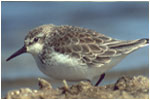| |
|
Gee Whiz Facts 
Did you know that...?
Egg laying by sandpipers in the Arctic is timed so that hatching will occur when the main hatch of insect food also occurs, thus providing the growing chicks with an abundant insect diet.
Some sandpipers in the Arctic ingest lemming teeth as a source of calcium for eggshell formation.
The calcium content of the shells of a four-egg sandpiper clutch is greater than the calcium content of the female, which laid the eggs.
Western Sandpipers weigh about 25 grams, which is less than one ounce. They lay four eggs, and each one of them weighs 7.5 grams. That's almost 1/3 of the female Western's Sandpipers body weight per egg.
Biologists think shorebird eggs are pointed on one end so that they can fit together smoothly in the nest in a pinwheel shape. This keeps more surface of each egg covered and helps them stay warmer during incubation.
Black-bellied Plovers have a migration that can be thousands of miles long, but they often return to build their nest within 300 feet of last year's nest.
Short-billed Dowitcher males are believed to roll their eggs to a new nest if threatened.
Shorebirds that breed in Alaska migrate to Australia, South Pacific Islands, Africa, Southeast Asia, the Lower 48 (contiguous) states, Central America, and South America to spend their winter.
Only seven species remain in Alaska in any significant number during the winter (Black Oystercatcher, Black Turnstone, Surfbird, Sanderling, Rock Sandpiper, Dunlin, and Common Snipe).
The diet of migrating Dunlins using Alaskan mudflats consists almost entirely of tiny clams.
Some plovers, curlews, and tattlers fly non-stop from Hawaii and other Pacific Islands to Alaska in two or three days, a distance of over 3,500 miles.
Up to one-half of some migrating sandpipers' body weight is deposited fat that provides energy for long distance flights.
Sandpipers are genetically programmed to stop, rest, and replenish their energy stores in certain wetlands along the Pacific coast from South America to Alaska. If one of these wetland areas is lost to development, sandpipers that depend on that area might not survive to migrate further.
Western Sandpipers migrate over 250 miles per day between stopover points along the Pacific coast flyway to Alaska.
Western Sandpipers stop to rest, feed, and replenish their energy reserves for three to five days in each stopover point in their migration northward along the Pacific coast to Alaska.
There are only 50,000 to 80,000 surfbirds in the world, and over 12,000 are known to stop in Homer, Alaska, during spring migration.
The total number of shorebirds along the Pacific Coast and worldwide is decreasing due to loss of wetland habitat.
Ruddy Turnstones may be the most playful of shorebirds. They frequent beachfront restaurants in Trinidad and Tobago to get handouts of French fries and cookies from customers.
The average Red Know, weighing 135 grams, gains 54 grams during its visit to Delaware Bay. To gain this much weight and to meet its daily energy needs, the Red Knot must consume roughly 1,052 grams of horseshoe crab eggs-about 285,000 eggs in all! Approximately 90,000 Red Knots do this every year. This is equivalent to a 150-pound person gaining 50 pounds in two weeks.
|
|
|
|

